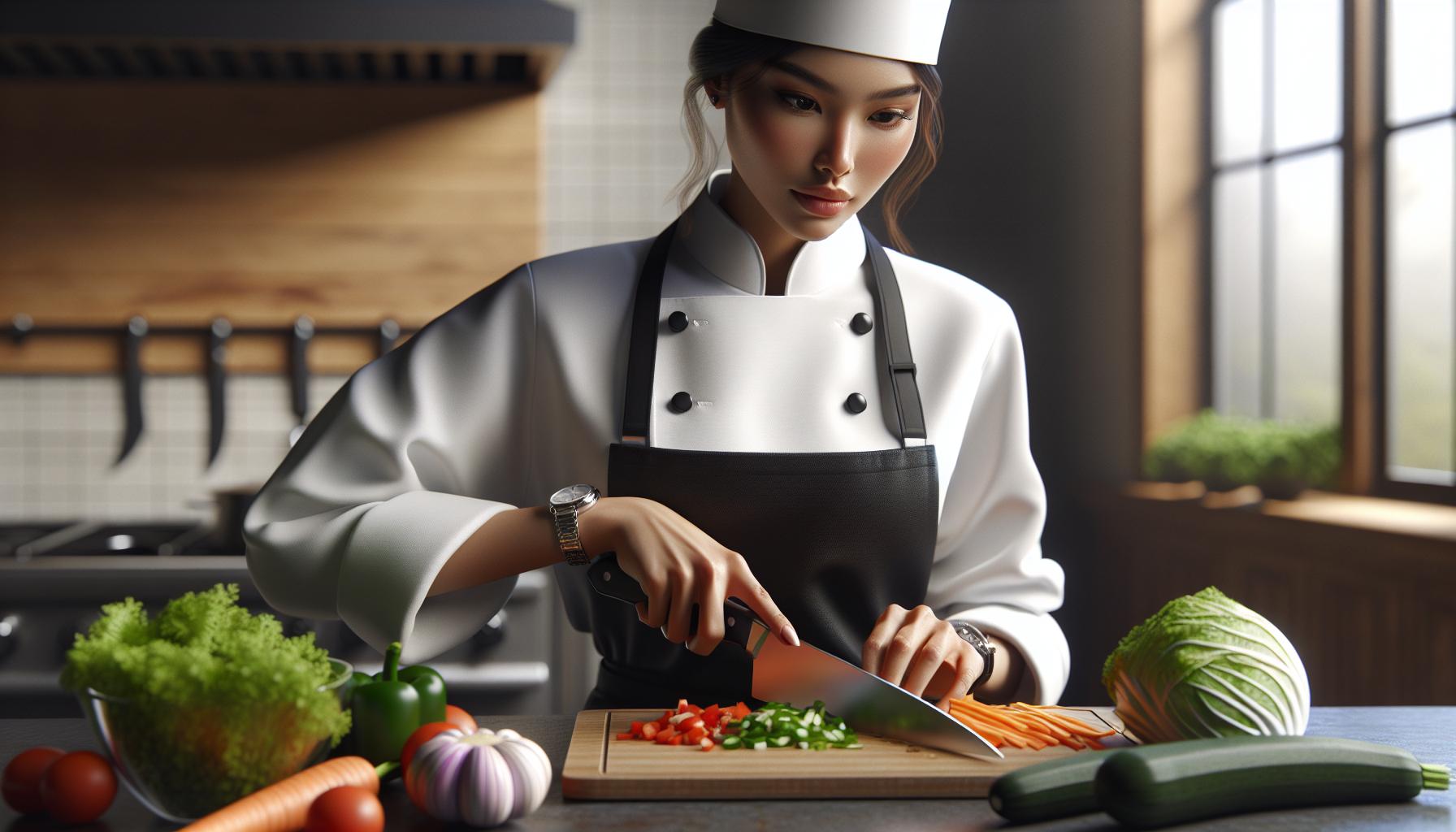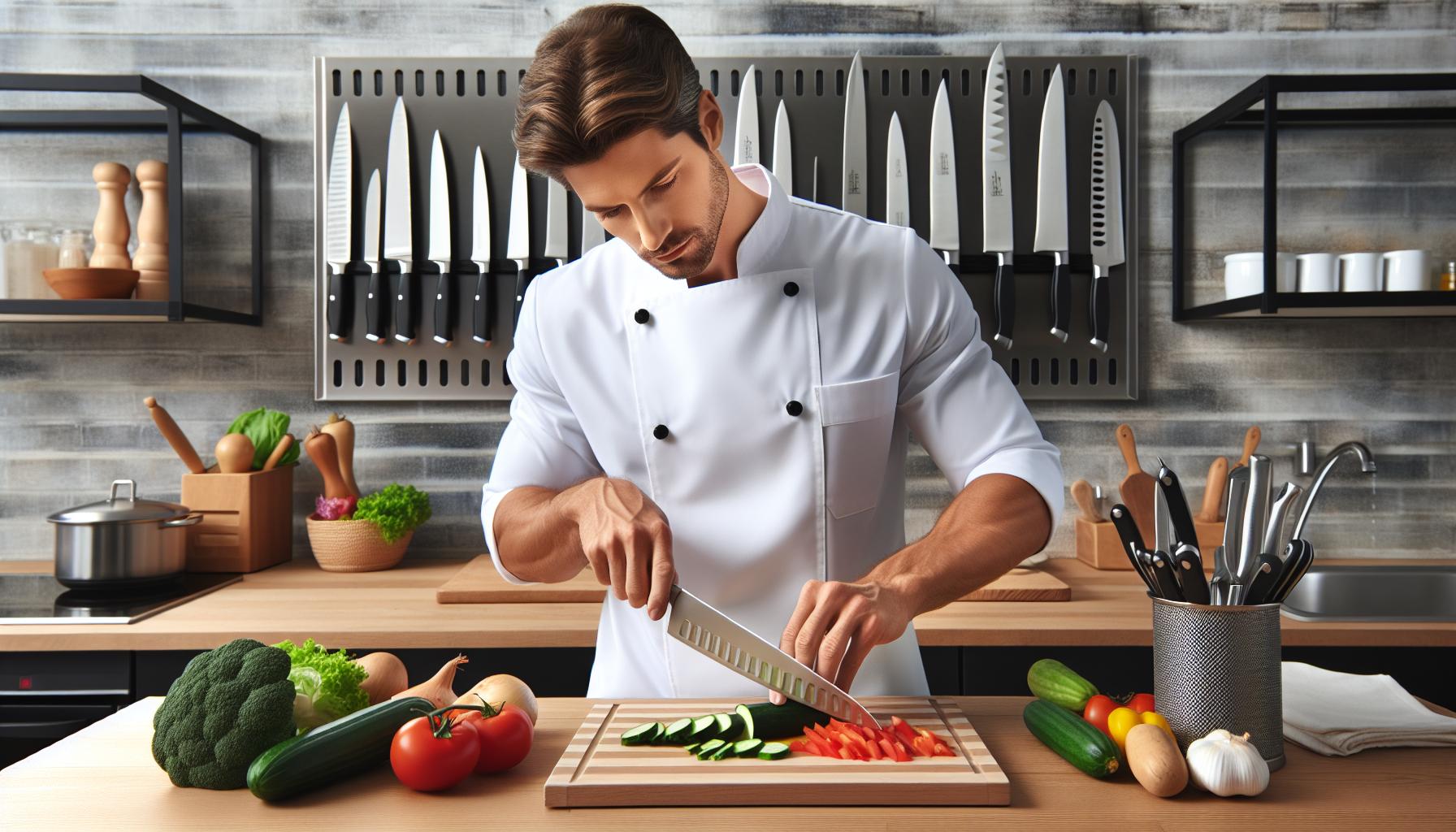Mastering the art of knife skills transforms ordinary home cooks into kitchen virtuosos. From the precise brunoise to the elegant chiffonade these essential cooking cutting techniques elevate both presentation and flavor while making meal prep a breeze. Whether you’re dicing onions without tears or creating Instagram-worthy julienned carrots proper knife work is the secret sauce behind professional-looking dishes.
Anyone who’s watched a chef effortlessly slice and dice knows there’s more to cutting than just hacking away at ingredients. The right technique not only ensures safety and efficiency but also affects how ingredients cook taste and look on the plate. From the basic cross-chop to the sophisticated tourné cut mastering these fundamental skills will revolutionize any cook’s kitchen game.
Cooking Cutting Techniques
Basic Grip and Posture
A secure knife grip forms the foundation of safe cooking cutting techniques. The pinch grip places the thumb on one side of the blade with fingers wrapped around the handle. Standing with feet shoulder-width apart maintains balance while keeping elbows close to the body creates stability.
Slicing Techniques
Slicing motions require a fluid forward push through ingredients while maintaining consistent thickness. The blade glides through food in one smooth motion without sawing. Common applications include:
- Cross-cut slicing for vegetables like cucumbers tomatoes
- Diagonal cuts for bias-sliced carrots celery
- Long slices for proteins such as chicken breasts fish fillets
Dicing Methods
Precise dicing creates uniform cubes that cook evenly. The process includes:
- Creating planks of equal thickness
- Cutting strips lengthwise
- Making crosswise cuts for cubes
- Maintaining consistent sizing for even cooking
Chopping Patterns
Chopping involves quick up-down motions with the knife tip anchored on the cutting board. The technique suits:
- Herbs like parsley cilantro
- Garlic cloves shallots
- Nuts seeds
- Small vegetable pieces
Knife Safety Practices
Professional knife handling incorporates essential safety elements:
- Curved fingers tucked behind knuckles while holding ingredients
- Clean dry cutting surfaces
- Sharp maintained blades
- Focused attention on cutting tasks
- Proper knife storage in blocks or magnetic strips
The section integrates seamlessly with the previous content by building upon fundamental knife skills while providing specific technical details for practical application.
Basic Knife Cuts and Techniques

Professional knife skills incorporate specific cutting patterns that enhance food presentation while ensuring consistent cooking. Each cut serves a distinct culinary purpose, from improving texture to controlling cooking times.
Slicing and Dicing Methods
Slicing creates long, uniform cuts ideal for vegetables like cucumbers carrots onions. A proper slice starts at the tip of the blade, drawing back in one fluid motion while maintaining consistent pressure. The three primary dicing cooking cutting techniques include:
- Large dice: 3/4-inch cubes perfect for root vegetables potatoes squash
- Medium dice: 1/2-inch cubes suitable for onions peppers celery
- Small dice: 1/4-inch cubes ideal for garnishes shallots garlic
Cross-cutting produces precise, even pieces by first cutting the ingredient into planks, then rotating 90 degrees for the final cut.
Julienne and Batonnet Cuts
Julienne cuts create thin matchstick shapes measuring 1/8 inch × 1/8 inch × 2-3 inches. These cuts enhance both presentation texture in:
- Raw vegetable salads
- Stir-fry dishes
- Garnishes for soups
Batonnet cuts measure 1/4 inch × 1/4 inch × 2-3 inches forming slightly larger matchsticks. This technique produces:
- French fries
- Crudité vegetables
- Roasted root vegetables
| Cut Type | Width | Height | Length |
|---|---|---|---|
| Julienne | 1/8 inch | 1/8 inch | 2-3 inches |
| Batonnet | 1/4 inch | 1/4 inch | 2-3 inches |
Advanced Cutting Techniques

Advanced cooking cutting techniques transform ordinary ingredients into professional-quality presentations through precise execution and specialized methods.
Chiffonade and Supreme Cuts
Chiffonade cuts create delicate ribbons from leafy greens or herbs. Fresh basil, mint or sage leaves stack together, roll into a tight cylinder, then slice into thin strips measuring 1/8 inch wide. The Supreme technique removes citrus segments from their membranes using angled cuts along the fruit’s natural divisions. This method starts by cutting off the top and bottom of the citrus, followed by removing the peel and pith in downward strips, then carefully slicing between membranes to release clean segments.
Specialty Vegetable Cuts
Tournée cuts shape vegetables into seven-sided football forms, commonly used for root vegetables like carrots or potatoes. The diagonal roll cut creates dynamic pieces by rotating vegetables a quarter turn between each angled slice. Paysanne cuts form thin, flat squares or diamond shapes measuring 1/2 inch on each side with 1/8-inch thickness. These decorative cuts enhance both visual appeal and texture in dishes like consommés or clear soups. Fluting mushroom caps involves scoring vertical lines from center to edge to create an ornate pattern that opens during cooking.
Knife Safety and Maintenance

Safe knife handling practices combined with proper maintenance form the foundation of efficient food preparation. These essential skills protect both the cook and the equipment while ensuring optimal cutting performance.
Proper Knife Handling
The pinch grip technique provides optimal control when handling kitchen knives. Chefs grip the blade between their thumb and forefinger near the handle while wrapping remaining fingers around the handle. A stable cutting board prevents slipping during food preparation through placement of a damp cloth underneath. The guide hand forms a claw position with fingers tucked under while holding ingredients, creating a protective barrier against cuts. Professional kitchens maintain a clear workspace around cutting areas to avoid accidental contact with sharp edges. Sharp knives require less force than dull ones, reducing the risk of slips or injuries.
Sharpening and Storage Tips
Regular honing with a steel rod realigns the knife edge between uses to maintain optimal sharpness. Professional sharpening services restore severely dulled blades using precision equipment three to four times per year. Magnetic knife strips or wooden blocks protect blades from damage while providing easy access during food preparation. Hand washing knives with mild soap preserves the blade edge compared to harsh dishwasher cycles. Storing knives in designated slots prevents contact with other utensils that could chip or scratch the blade surface. Edge guards shield knife blades during transportation or storage in drawers. Professional kitchens implement color-coded handles to prevent cross-contamination between different food types.
Professional Chef Cutting Methods
Professional chefs employ specialized cooking cutting techniques that create uniform pieces for consistent cooking results. Mastering these precise cuts enhances food presentation while ensuring optimal flavor development.
Classic French Cuts
- Brunoise: Creates 1/8-inch cubes by dicing julienned vegetables
- Batonnet: Produces 1/4-inch x 1/4-inch x 2-inch matchstick cuts
- Allumette: Forms thin 1/8-inch x 1/8-inch x 2-inch strips
- Paysanne: Yields 1/2-inch x 1/2-inch x 1/8-inch thin square cuts
Specialty Techniques
- Tourne: Shapes vegetables into 7-sided football forms
- Supreming: Removes citrus segments without membrane
- Fluting: Creates decorative ridges on mushroom caps
- Lozenge: Cuts ingredients into diamond shapes
| Cut Type | Size | Common Uses |
|---|---|---|
| Julienne | 1/8″ x 1/8″ x 2″ | Garnishes salads |
| Jardinière | 1/4″ x 1/4″ x 1″ | Root vegetables |
| Chiffonade | Paper-thin ribbons | Leafy herbs |
| Macedoine | 1/4″ cubes | Mixed vegetables |
Professional chefs maintain blade alignment through each cut using controlled forward motion. Cutting boards remain secured with damp towels underneath to prevent movement. Each technique requires specific knife angles matched to ingredient texture for optimal results.
Regular practice develops muscle memory essential for executing these cuts efficiently. Professional kitchens organize mise en place using uniform cuts to ensure consistent cooking times across ingredients.
Best Knives for Different Cutting Tasks
A chef’s knife (8-inch) excels at chopping vegetables slicing meats mincing herbs. Its versatile blade handles 90% of kitchen cutting tasks with precision control.
Specific cutting tasks require specialized knives:
Paring Knife (3-4 inch)
- Creates intricate garnishes
- Peels fruits vegetables
- Deveins shrimp
- Makes detailed cuts in small ingredients
Bread Knife (10 inch)
- Slices crusty breads without crushing
- Levels cake layers
- Cuts delicate pastries
- Portions soft fruits like tomatoes
Santoku Knife (7 inch)
- Dices vegetables uniformly
- Creates paper thin slices
- Minces herbs finely
- Chops proteins precisely
- Portions sandwiches
- Cuts medium sized vegetables
- Slices cheese
- Trims fat from meat
| Knife Type | Primary Use | Ideal Blade Length |
|---|---|---|
| Chef’s | All-purpose | 8-10 inches |
| Paring | Detail work | 3-4 inches |
| Bread | Crusty items | 10-12 inches |
| Santoku | Precise cuts | 5-7 inches |
| Utility | Medium tasks | 4-6 inches |
Professional kitchens incorporate specific blade angles:
- Western style knives: 20-22 degree edge
- Japanese style knives: 15-17 degree edge
- Serrated knives: 22-30 degree edge
- High carbon steel: Superior edge retention requires maintenance
- Stainless steel: Resists corrosion needs frequent sharpening
- Damascus steel: Combines durability with edge retention
- Ceramic: Maintains sharpness lightweight brittle
Ensure Kitchen Safety and Efficiency
Mastering proper cooking cutting techniques is essential for any aspiring home cook or professional chef. These fundamental skills not only enhance the quality and presentation of dishes but also ensure kitchen safety and efficiency.
With dedicated practice and attention to proper form anyone can develop professional-level knife skills. The journey from basic cuts to advanced techniques opens up new possibilities in cooking while making food preparation more enjoyable and rewarding.
Remember that good knife skills are built on a foundation of proper technique safety and maintenance. When combined with the right tools these skills transform ordinary ingredients into restaurant-quality dishes that delight both the eye and the palate.

